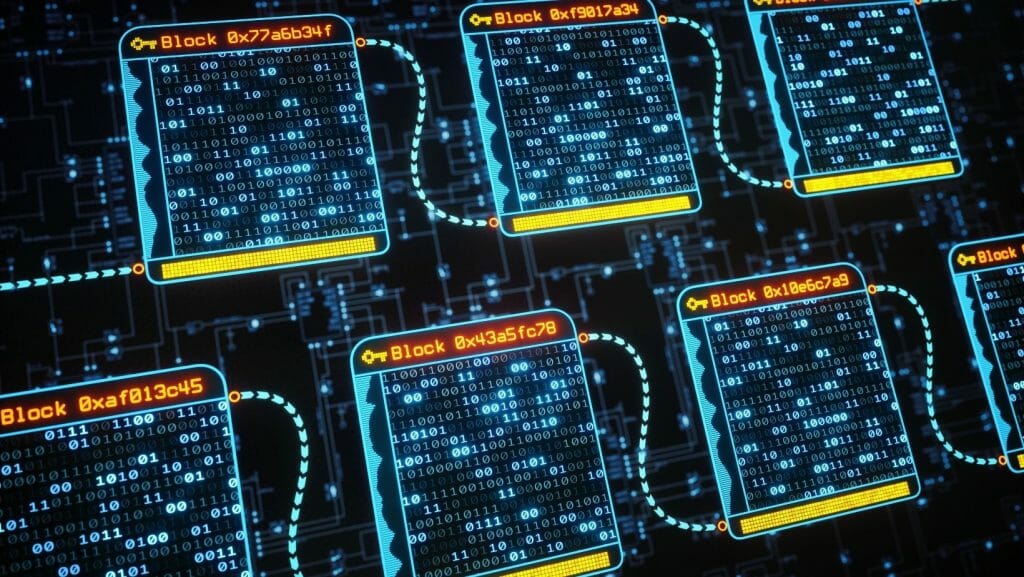If you have been following the news about digital currencies in the last ten years or so, you have certainly come across the term blockchain – the technology on which all cryptocurrencies are based, and much more.
Although the term blockchain sounds complicated to many, the basis of this technology is extremely simple. A blockchain is a type of database that contains an electronic collection of data stored on a computer. Typical databases are mostly structured in a table format for easier data retrieval and filtering and are stored on servers with a powerful hardware infrastructure – strong hardware, in layman’s terms. There is not much to talk about the popularity of this technology; suffice it to mention that the largest telecommunications operators have started investing in blockchain and cryptocurrencies.
Data Storage Structure
Unlike a classic database, a blockchain collects data into groups (blocks), which contain sets of information. The blocks have a certain capacity, and when it is filled, the block connects with the previous block in a row, forming a chain of blocks – whence the name of this technology. All new information that is further generated fills a new block, which is added to the chain when it is filled with data.
While databases structure their data into tables, blockchain structures its data in the form of blocks, which are interconnected. The advantage of connecting blocks to each other allows a constant time flow of creating and merging blocks. When a block is filled with data, it can no longer be changed and becomes part of the chain, with the exact data of when it is added to the chain, so that this data cannot be manipulated.

Decentralization and Nodes
To understand blockchain properly and how it works, the simplest way is to show it on the principle of the Bitcoin cryptocurrency. Like any database, Bitcoin requires a certain number of computers on which to store its blockchain. It is important for Bitcoin because it is the base where all Bitcoin transactions ever made are stored. Unlike traditional databases, Bitcoin’s blockchain is decentralized, which means that a large number of physically remote computers in the world have a copy of Bitcoin’s blockchain.
Just as large companies have a large number of their servers in one location and have complete control over them, so Bitcoin’s blockchain consists of thousands of computers around the world, and each of these computers is managed by someone else. These computers that form Bitcoin’s blockchain are called nodes. Of course, Bitcoin’s blockchain is decentralized, but there are also private centralized blockchains, which means that all the computers that make up the blockchain are managed by one entity.
Security and Immutability
In a chain of blocks, each node has a full record of the data stored in the chain since its creation. For Bitcoin, this means all transactions, including those two big pizzas purchases in 2010 – which is the case known as Bitcoin Pizza Day (a certain Laszlo Hanyecz agreed to pay 10,000 bitcoins for two delivered Papa John’s pizzas).
Each node has a full record of all transactions to prevent manipulation of previously entered data. If one node has an error in its data, it can use data from thousands of other nodes to compare and possibly correct incorrectly entered data. Precisely because of decentralization, it is impossible for a node in the network to change previously entered information, and because of that, the existing Bitcoin’s blockchain is immutable backward.

Transparency
In addition, the list of transactions is transparent and publicly available. Therefore, Bitcoin’s blockchain contains a list of transactions, but other data such as a company’s inventory, signed contracts, and similar information can also be entered into the blockchain.
The decentralized nature of Bitcoin’s blockchain network allows for complete transparency, which means that anyone who is a node or uses one of the blockchain explorer tools can follow live transactions as they unfold. As each node has its own copy of the chain that is updated after adding a new block, it is possible to track the movement of each of Bitcoin’s coins.
One good example is the hacking of large exchange offices that have lost huge amounts of cryptocurrencies. Although hackers can be anonymous, as well as the wallets to which the coins are transferred, any bitcoin can be tracked, so if someone wants to spend or move stolen coins, it is easily detected and further tracked. So, the FBI recently seized 63 Bitcoin coins from a hacker who got the coins during a ransomware attack on a U.S. pipeline.
Security
One of the most common issues related to cryptocurrencies, and therefore to blockchain technologies, is security. Blockchain provides security in several ways. The first and basic is the linear and chronological addition of blocks to the chain because they are always added to the end of the chain. The position of each block in the chain is called height and is determined depending on the distance from the first block. If you look at Bitcoin’s blockchain, 688,190 blocks were added at the time of writing, which is also its height.
When a block is added to the end of a chain, it is very difficult to go back and change the contents of the block unless most nodes agree to the change. Namely, each block has its own hash code. They are created using complex mathematical functions that convert digital information into a series of numbers and letters. In order for a block to be added to the end of the chain, it must have its own hash code, as well as the hash of each block before it, which is very important for network security. For example, if a hacker wants to modify a blockchain and steal bitcoin from the owner, he must change his copy of the block. However, before adding a block to a string, all nodes check the hash of the new block and whether it matches the previous one. When everyone checks their information and notices that one copy is different, it is clear that it will be rejected as invalid.

The So-Called 51 % Attack
The consensus of nodes when adding a new block is achieved by a simple majority. When everyone compares their copies with the hash code of the new block, if there is a validation of 51 % of the nodes, the block is added to the end of the string. Theoretically, if someone controlled 51 % of the nodes, he could write blocks at his discretion, and then their copy would become a copy of the majority and thus a valid chain. To achieve this with a blockchain network of some of the larger cryptocurrencies such as Bitcoin or Ethereum (which are also used for online gambling at best world casino websites – such as best Aussie casinos), they would need a huge amount of money and resources because they would have to re-enter all the blocks, which would have new hash codes and timestamps.
In the case of these large networks, this is practically unfeasible and unprofitable, but ’51 % attacks’ often happen with blockchain networks of smaller cryptocurrencies that do not have many nodes, so reaching a 51 % consensus is possible with much less investment.
Earnings
In order to maintain the blockchain network, the mentioned nodes are needed. In order for a new block to be inserted at the end of the chain, it is necessary to create and verify its hash code, together with the hash codes of the previous blocks, which requires a huge amount of specific computing power. When a block is verified, the node that verified it receives a reward in the form of a certain amount of Bitcoin’s coins.
It is this reward system for a successfully created and verified block that attracts miners to get involved in the verification process. Specific hardware, especially graphics cards, is very efficient in the process of solving these complex tasks, so every time you see ‘farms’ of cryptocurrencies, you see piles of graphics cards, or specific hardware called ASIC miner, made just for mining.
Since only one miner receives a reward for each new block, the miners team up in so-called pools and join forces to combine their computing power. In this way, the reward from each mined block is divided among the members of the pool, according to the invested computer power. For example, if the total computing power of the pool is 1 Th/s and your rigs allow about 500 Mh/s for each mined block, you will receive a 0.0005 % reward. However, as the rewards are not small, and the high power of the pool means a higher probability of mining blocks, depending on the power of the graphics in your rigs, you can calculate with great accuracy how much your earnings will be on a daily basis. After all, how profitable it is to mine cryptocurrencies has become clear when police around the world come across cryptocurrency mining farms instead of drug plantations.
Blockchain Use
In the case of the Bitcoin network, a chain of blocks contains information about transactions, but as we have already said, other information can be entered into the blockchain. This is where the advantage of blockchain technology lies. Large companies such as Siemens, Unilever, Pfizer, IBM, and others, and even countries like China, have been using and developing blockchain in their business processes for some time.
A good example is the Food Trust blockchain, created by IBM and used to track food from its source to its final destination. This is designed to prevent epidemics of Escherichia coli, salmonella, listeria, and similar dangerous substances that can be found in food. In the past, it was very difficult, sometimes almost impossible, to trace the sources of these epidemics and the causes of mass poisonings, which the blockchain changed radically. The use of blockchain technology enables the tracking of food from its source through each package and transport to the place of delivery. If a food is found to be contaminated, all steps can be taken from start to finish to determine the time of infection, which can potentially save many lives.
Blockchain and Finance
One of the industries that can have great benefits from integrating blockchain technology into its business operations is banking. One simple example is working hours. Most banks work five to six days a week, so it is possible that some payments from Friday will wait until Monday for realization. On the other hand, the blockchain never sleeps, and transactions are carried out in a very short time, regardless of whether it is a working day, two in the morning, a holiday, or a weekend. On the other hand, banks could exchange finances much faster between institutions such as stock exchanges without waiting to process large transactions.
According to some financial institutions, savings through the use of blockchain technology could be measured in tens of billions of U.S. dollars annually, and that only for some of the biggest ‘players’. Cryptocurrencies also allow money to move outside the borders of countries, where the whole world is seen as a single market, thus bypassing large fees for money that needs to be transferred from one country to another.
Blockchain is an ideal solution for healthcare because it enables the safe storage of patient data. Land registers are also an area in which blockchain data storage technology can provide a linear system for verifying ownership of land and real estate. Blockchain in the voting system prevents any embezzlement.

Pros and Cons
As one of the revolutionary technologies, blockchain potential is almost infinite. From privacy and enhanced security to lower transaction costs and fewer errors, the blockchain will undoubtedly be used in many other areas in the future. By excluding the human factor from the verification process, accuracy is increased, and costs are reduced because verification does not require the involvement of a third party. Blockchain decentralization prevents fraud while transactions are secure, private, and efficient, and the whole process is transparent.
On the other hand, maintaining a blockchain network requires a large amount of computing power, which means high power consumption, which is mainly associated with ‘dirty’ power sources. Add to that the history of using cryptocurrencies for illegal activities, as well as the lack of regulations, blockchain is a revolutionary technology, which, with small corrections, will be one of the leading data storage systems and many other applications in the future.


